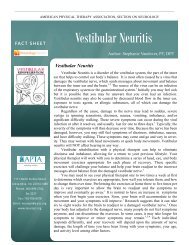Practice Guidelines for BPPV - Neurology Section
Practice Guidelines for BPPV - Neurology Section
Practice Guidelines for BPPV - Neurology Section
Create successful ePaper yourself
Turn your PDF publications into a flip-book with our unique Google optimized e-Paper software.
Vestibular SIG Newsletter <strong>BPPV</strong> Special Edition<br />
practices. Both the AAN and AAO-HNS examined the<br />
necessity of post-maneuver instructions following<br />
treatment of <strong>BPPV</strong>. The research reviewed by the AAN<br />
discussed one Class I study and two Class II studies that<br />
demonstrated positive outcomes using the CRP as a<br />
treatment without using any post-treatment instructions<br />
or restrictions. However these studies were not designed<br />
to evaluate the use of post-treatment instructions and/or<br />
restrictions. Five out of six Class IV studies that were<br />
designed to examine these factors showed no added<br />
benefit from post-treatment activity restriction or<br />
positions. The sixth showed minimal benefit in the use of<br />
these restrictions as demonstrated by a reduction in the<br />
number of Dix-Hallpike maneuvers needed to produce a<br />
negative result as compared to the control. The AAO-<br />
HNS guidelines reported similar findings and concluded<br />
that there is “insufficient evidence to recommend postmaneuver<br />
restrictions in patients treated with CRP<br />
(Bhattacharyya et al, 2008).<br />
Another practice that varies following treatment of<br />
<strong>BPPV</strong> is the provision of self-treatment guidelines.<br />
Reasons cited <strong>for</strong> providing the self-treatment<br />
instructions include the relatively high recurrence rate of<br />
<strong>BPPV</strong> and to improve efficacy of the treatment provided<br />
in the clinic. Those who caution against the use of self<br />
treatment maneuvers describe the practice as detrimental<br />
to those cured with one maneuver in the clinic because<br />
the positions in the self-treatment may cause a<br />
recurrence. The AAO-HNS guidelines describe three<br />
studies that examined the use of self-treatment<br />
maneuvers <strong>for</strong> the treatment of posterior canal <strong>BPPV</strong>.<br />
One study found slightly greater improvements in<br />
persons provided with self-administered CRP<br />
instructions following CRP treatment in the clinic.<br />
Another study found self-administered CRP to be more<br />
effective than Brandt Daroff exercises (64%<br />
improvement compared to 23% respectively). Finally, a<br />
third study found the use of a self-CRP more effective<br />
than using a modified Semont maneuver (95% resolution<br />
compared to 58% respectively) (Bhattacharyya et al,<br />
2008). The guidelines from the AAO-HNS conclude,<br />
“in motivated individuals, self-treatment of <strong>BPPV</strong> may<br />
be an option” (Bhattacharyya et al, 2008).<br />
<strong>Practice</strong> <strong>Guidelines</strong> (cont.)<br />
9<br />
The AAN guidelines described similar findings and also<br />
cited studies that concluded that the most effective self<br />
treatment <strong>for</strong> posterior canal <strong>BPPV</strong> is the self CRP.<br />
However, due to the limited research found the AAN<br />
concluded “there is insufficient evidence to recommend<br />
or refute using Semont maneuver or CRP <strong>for</strong> <strong>BPPV</strong>”<br />
(Fife et al, 2008).<br />
The use of medication in conjunction with other<br />
treatments to manage <strong>BPPV</strong> has also been the subject of<br />
debate when treating persons with <strong>BPPV</strong>. The types of<br />
medications commonly prescribed <strong>for</strong> <strong>BPPV</strong> include<br />
benzodiazepines (i.e. diazepam, and clonazepam) and<br />
antihistamines (i.e. meclizine and diphenhydramine).<br />
Benzodiazepines can reduce the subjective sensation of<br />
spinning but they may also interfere with vestibular<br />
compensation. Antihistamines are used because of their<br />
ability to suppress the central emetic center, which can<br />
reduce the nausea and emesis than can be experienced<br />
with <strong>BPPV</strong> (Bhattacharyya et al, 2008). The AAN<br />
concluded that there was “no evidence to support a<br />
recommendation of any medication in the routine<br />
treatment <strong>for</strong> <strong>BPPV</strong>” (Fife et al, 2008). The conclusion<br />
described by the AAO-HNS also lacked support of the<br />
use of medication to treat <strong>BPPV</strong> and described potential<br />
harmful effects of using medication due their potential<br />
side effects and ability to dampen the response of the<br />
vestibular system which may decrease diagnostic<br />
sensitivity during <strong>BPPV</strong> testing. For these reasons, the<br />
AAO-HNS recommended against (Grade C) using<br />
medications to treat <strong>BPPV</strong>. The only exception described<br />
was when used in conjunction with the recommended<br />
treatments <strong>for</strong> <strong>BPPV</strong> on a short-term basis to control<br />
symptoms such as nausea and vomiting in a person<br />
experiencing these symptoms so intensely that the<br />
standard treatment may not be possible without them<br />
(Bhattacharyya et al, 2008).

















